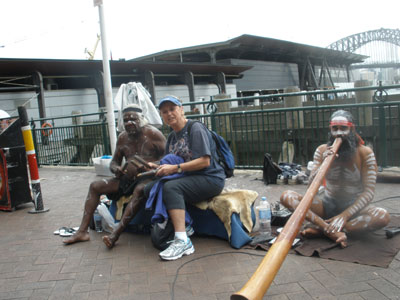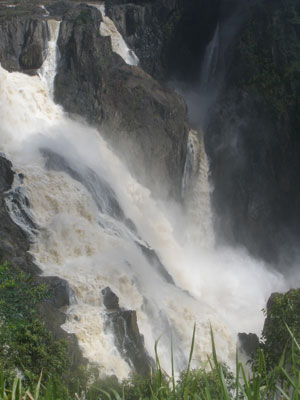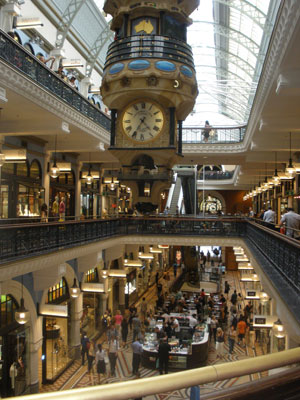Having an ‘Aussie-um’ time Down Under
by Sharon VanDewark; San Diego, CA Standing in front of the most massive rock I had ever seen, I couldn’t help remembering when, a few months earlier, I was only thinking of this moment. Finally, here it was! For many years I had anticipated visiting Australia and New Zealand. After reading travel writer Bill Bryson’s book “In a Sunburned Country” four times, I decided it was high time I visited the lands Down Under. In February ’11, I flew from Los Angeles to Sydney on United for a too-short five-day stay in Australia.
Starting in Sydney
My travel arrangements were made by Irene Rangel of the Auto Club of Southern California (12630 Sabre Springs Parkway, San Diego, CA 92128; 800/444-8091), who suggested making touring arrangements through Brendan Vacations (Chatsworth, CA; 800/421-8446). They booked all of the tours to the sites I wanted to visit, led by local operators, for a total of around $1,500, including transfers and accommodations. After checking into the Travelodge Sydney (phone 61 2 8267 1700), I walked three blocks and took the free tourist bus to Circular Quay (pronounced “key”) at Sydney Harbour, a wonderful people-watching spot with access to many ferries and only steps away from the Sydney Opera House. The beautiful Opera House offers tours of its interior — it’s best to make reservations ahead of time — and there, arching over the water just behind it, was the huge Harbour Bridge. What a sight! I could see, way up on top, tiny figures of people making their way across the top of the bridge. I had walked about 30 feet when I heard the melodic sounds of a didgeridoo, a northern Australian wind instrument. There were three Aboriginal men with designs painted all over their bodies entertaining crowds at the quay. Yes, I really was in Australia!
I took one of the many ferries located at the quay to beautiful Manly Beach, well known for its surfing. I passed by a Royal Copenhagen Ice Cream shop and couldn’t resist their “hokey pokey” ice cream. I was told you have to have hokey pokey in Australia; the honeycomb-and-butterscotch ice cream was delicious. In fact, it was so good I returned to the shop to let the girl know how much I had enjoyed it! After returning on the ferry to Sydney, I walked back to my hotel via George Street (the free tourist bus had stopped running in late afternoon), visiting the Queen Victoria Building shopping center and the Pitt Street Mall along the way. Dating to the 19th century, they were filled with boutiques and shops.
On to Uluru
The next day I took a short two-hour flight on Qantas to Uluru (Ayers Rock) in the Northern Territory. As soon as I stepped out of the airplane, I could see Uluru in the distance. I have to say it was one of those ‘Wow!’ moments. A short while after checking into the Lost Camel Hotel (phone 61 8 8957 7888), my AAT Kings tour bus picked me up for a sunset viewing of Uluru. We stopped in a parking area about a mile away from Uluru along with many, many other tour buses from hotels in the area. Our group members enjoyed wine or lemonade and nibbles while the sun slowly made the shadows deepen on the rock. Aha! I realized that it was the time of day or the weather that caused the rock’s colors to change from tan to burnt siena to dark red. From the large crowd gathered, I could hear a collective “Ahhh” as the colors and shadows shifted. The only other sound was the click-click-click of cameras.
Nature walk
The next morning the tour bus drove us 16 miles west of Uluru to a large group of conglomerate rocks called Kata Tjuta (known locally as The Olgas). Located in Uluru-Kata Tjuta National Park, it is a UNESCO World Heritage Site. There is an entry fee of AUD25 ($25). Kata tjuta means “many heads,” a reference to the 36 huge domes. We stopped at Walpa Gorge to walk around for an hour, admiring the rock formations on the other side. We had gone only a short distance when I felt the pitter-patter of raindrops. It was very humid when I had left the hotel a half hour before and the thought of taking a rain jacket or an umbrella never occurred to me. Soon the rain stopped, so I continued walking with a few other people. I wasn’t about to turn back because of a little rain. The rocky path was very slippery from the rain, and ribbons of water were falling down the barren sides of Kata Tjuta. I continued on for another half mile… and then the heavens opened up.
It poured in a torrent of rain, with the wind in the gorge so strong, it was hard to walk on the slippery rocks. I decided to turn around, only to discover I was totally alone — not another person in sight. “Oh, great,” I thought. There was nowhere to take shelter, so I just kept going. By now, the water coming off the rock was a waterfall washing over the trail and over the top of my jogging shoes, but I just kept squishing along. When I reached the bus 30 minutes later (by which time the rain had stopped), I was 100% soaked. I looked like a drowned rat, but that’s traveling! This walk, which I will never forget, only added to the “I’m not in California anymore” experience. The next morning we had our ranger-guided walk at Uluru. The ranger shared so much knowledge during the two-hour talk that it was impossible to remember all of it. The walk ’n‘ talk went by all too quickly. He pointed out red ocher and charcoal aboriginal drawings and petroglyphs on the rock in different places. We were then free to walk around the entire base of Uluru (six miles, which takes 2½ hours). Though only 10:15, it was terribly hot and humid, with pesky flies constantly hovering around, so I opted to return to my hotel. The following day I enjoyed my last view of Uluru as I flew north up to Cairns, the gateway to the Great Barrier Reef.
The Great Barrier Reef
Cairns is a part of the Wet Tropics of North Queensland. This temperate tropical area frequently gets rain, even during Australia’s summer (known as the wet season). I had a great hotel there, the Mercure Cairns Harbourside (phone 07 4051 8999), overlooking the Esplanade, which stretches to the downtown area. It was a great place to walk, see the many art objects and enjoy the fragrance of the many frangipani (plumeria) trees. The next day included a scheduled catamaran trip out to the Great Barrier Reef for diving or snorkeling and lunch. The trip, with Reef Magic Cruises (phone 61 7 4031 1588), took us 90 minutes out to an area marked off for snorkeling, then it was two hours of fun! fun! fun! Lycra suits that covered you completely were passed out or you could change into a bathing suit. Snorkels and face masks also were provided. While snorkeling in the luminous water, I saw the underwater photographer motion for me to come nearer. There was a huge speckled blue Napoleon wrasse fish, perhaps four feet long, but just as she snapped the photo of me looking at it, it turned away. The “Kodak moment” was lost. I had to be content with enjoying a day looking at life underwater. The sun finally came out, turning the water a beautiful, sparkling tourmaline blue. It was a perfect day, which included a lot of sunscreen. The buffet lunch on board was very well prepared and enjoyable.
Rail excursion
I had heard a lot about the Kuranda Scenic Railway and the Skyrail Rainforest Cableway, both located near Cairns, so I prepaid for an excursion. A tour bus picked me up at my hotel and took me to Freshwater Station, just a few miles from Cairns.
I checked in at the station and had a few minutes to look through their very interesting museum before boarding the train to Kuranda. The beginning of the ride reminded me of being in Hawaii with all the fields of sugarcane. Slowly we climbed, traveling through dense forests and passing beautiful waterfalls. The overlook at Barron Falls was the first train stop. The distant thundering falls cascaded down into Barron Gorge. The train continued to Kuranda Village, with many places to eat, jewelry stores featuring opals and tourist shops. There was also a butterfly sanctuary (admission charged).
Into the air
I walked around before hopping onto the Skyrail. The gondola could hold six people, and two stations/stops offered photo ops. It took us very high above the rainforest, steep ravines, cascading Barron Falls and the Barron River. I got out at the Barron Falls stop for a better look over the falls, nearly a half mile away. There were many safe and well-maintained walkways allowing different views of these mighty falls. At this stop, photos showed how the workers who built the railway, opened in 1891, had blasted out tunnels using dynamite, hand tools and hard work. It took my breath away to see the rudimentary materials they had to work with, yet they accomplished so much. Getting back into the aerial tram, I went up to the next stop, Red Peak Station, where a very knowledgeable ranger led us through the rainforest. This was a beautiful corner of the rainforest, and I expected to see Tyrannosaurus rex galumphing through at any minute (but all I saw was a bush turkey). All kinds of beautiful basket ferns were attached to the trees, and orchids were tenaciously fastened to the tree trunks. There were strangler figs, ginger plants and, of course, many palms. The ranger talked for about 20 minutes, not nearly long enough, telling us fascinating facts about the rainforest and the animals that live there. It was time to get back in the gondola and continue my ride to the bottom, where there was a very nice gift shop and a small café. The bus picked me up on time and took us all back to our various hotels. There was still time to walk downtown (with a plumeria sprig tucked behind my ear) and enjoy the sights. The following day, I flew from Cairns back to Sydney to continue my wonderful Down Under vacation with a cruise to New Zealand on Holland America’s Volendam. But that’s a whole ’nother story. This holiday was fantastically wonderful.




